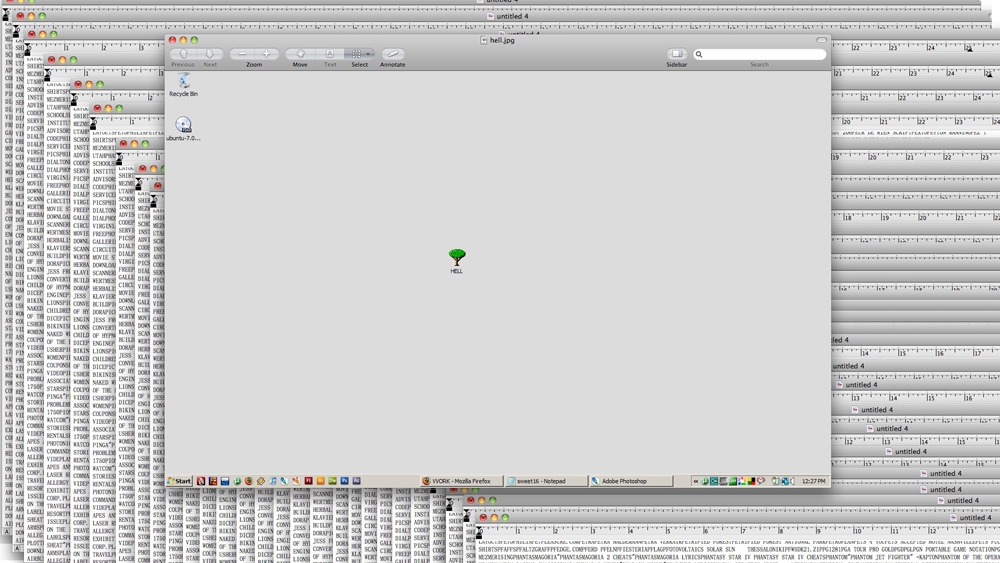‘What is reading? How does reading turn into knowing? What is a book? Is reading a book different from reading a menu, or an affidavit, or a painting? Why are books associated with bodies? When books are burned, why is it natural to assume that people are next? How do you burn an e-book?’ These are some of the questions from the blurb for Wht Is a Book?, an e-book by New York artist Paul Chan, published in 2011 by the imprint that he founded in 2010, Badlands Unlimited.
The most radical e-books are more akin to artworks than to conventional publications
Badlands, which Chan runs in partnership with Ian Cheng and Micaela Durand, is an extraordinary experiment in publishing, most notably for its exploration of the e-book form. Its publications include the Wht Is series, each focused on a high-sounding question, and in which found pages are overlaid with unattributed quotes and images of Internet memes. Other works include Hell_Tree (2013) by Petra Cortright, an astonishing collage of the digital debris at the edges of this net artist’s life. The outfit’s most radical e-books are more akin to artworks than to conventional publications; and although they do not revel in interactivity or animation for the sake of it, they are completely a product of the digital age.
One of the curious things about Badlands is how few other people are making art e-books that come anywhere close to this level of interest. It is now apparent that e-books have taken off in some areas, such as novels and children’s books, whereas other sections of the market have remained stubbornly print-bound; and art publishing is an area in which take-up for e-books is relatively low.
This may in part be because the various software and hardware combinations that can come together to make an e-book are not always conducive to making art publications: Kindles, for instance, have traditionally been best suited to simple text-led narratives. More obviously, the e-book fails to provide the ‘object’ character that is arguably more important for art books than for many kinds of publications.
Whatever the reason, the result has been a stunted market for art e-books, and one in which few of the larger art publishers and art organisations have shown much sign of innovation. In Britain, for instance, Thames & Hudson has mainly restricted itself to text-led e-books. Phaidon and Tate, meanwhile, have produced some art books for iPad, but usually offering a rather basic version of what an e-book can be, allowing the viewer to expand some images and keywords but with little more in terms of augmented features. However, more interesting publications are slowly starting to appear from such sources. One excellent new release from Phaidon is A New York Minute (2013), which features a simple sequence of short street films by the American photographer Stephen Shore.
Among smaller publishers the picture is similarly patchy. There are some outfits that are producing excellent text-led publications, including Strelka Press, the publishing arm of the Moscow-based Strelka Institute, which publishes polemical e-books on its specialist subjects of architecture and design. There are also some smaller publishers that have been making interesting art books for iPad, including the Green Box, a Berlin-based press that has made a number of e-books that are ambitious in their use of multimedia elements. One of the most active small publishers is the London-based MAPP, the core of whose list is made up of picture books by contemporary photographers, as well as reissues of out-of-copyright photography classics.
What is most often missing from the scene are e-books that really explore the potential of the technology, and that think about what a book might be in the digital age. This is what makes the titles issued by Badlands such a joy. One such is How to Download a Boyfriend, which the publishers speculate is the first group show published as an e-book, and which contains a riotous mix of pages by different artists, featuring many photo-based works drawing on digital and popular culture, interspersed with interactive quizzes on love and sex. In addition to their playful queerness, publications such as these – which substitute a conventional textual narrative with images, audio, found material and errant voices – can be seen as part of Paul Chan’s extended answer to the question posed by Wht Is a Book?
This article was first published in the April 2014 issue.
